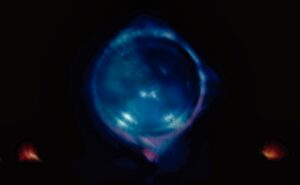By Kate White, MA, BCBMT, RCST®, CEIM, SEP, PPNE
John Chitty, RPP, RCST®, (1949-2019) had many passions in his work: The two-chair method (working with polarity and pendulation), babies, relationships, energy medicine, states of health versus pathology, and autonomic nervous system state change. He had advice for every occasion from personal tragedy to business practice. He told several stories over and over again, which clued me into things he was most passionate about. One of them was the following, stated in an adamant and sometimes outraged insistent tone:
“I have people coming in here and telling me that they want to get to root of their trauma to be rid of it once and for all. Well, I don’t think that you need to get to the root of trauma; all you need is state change. (picks up hand and points at me) State change is the name of the game” (inflection and repeated pointing with every word).
“Yes sir!” I’d say.
Now, those of you who knew John knew he was not the kind of guy you had to say, “Yes sir,” to. So, this was in jest, but also in recognition that he cared seriously about this topic. What set the stage for this familiar exchange was often a story from my world of prenatal and perinatal trauma, or a case study, or an article or book chapter about recapitulation. Trauma healing enthusiasts these days are more aware than ever of the dangers of cycling over the same trauma story many times, or going too quickly to the difficult experience without resourcing, or chasing after the root cause only to be disappointed or worse, have a therapist make up the story based on their experience. My training in Somatic Experiencing® included stories where therapists made up what they thought happened to the person, and the story stuck thus becoming another layer of trauma for the client. Well meaning, but thoroughly wrong interpretations from therapists happen, especially in the pre and perinatal trauma realm.
John didn’t really want to help people find their root trauma, often one that included implicit early experiences like those I specialized in healing. So you can imagine our conversations at times. I maintain that if the therapist can recognize the implicit early memory and sometimes even correctly name it, then the therapeutic field can settle. But the therapist needs to be careful— a wrong story can retraumatize. Hence John’s approach: Work with the state. State change is the name of game. Let’s discuss.
John called the layers of a person’s experience fields of action and within each field there were sequences. These sequences were all related to the three nervous systems: social engagement, sympathetic, or parasympathetic, and within these, states of function, stress or threat responses, and all markers of health. If a person comes in to heal a stress response that looped continually in and out of parasympathetic shock, the practitioner’s job is to recognize the state first, then use the five practitioner skills to work with states to change them and integrate the person’s experience into the present. The story did not matter as much as the state.
Part of John’s mastery was not only his capacity to recognize state and somatic language (facial expression and gesture), but his use of verbal skills, particularly open-ended inquiry. Many times, when I presented a dilemma to John, he said, “Well, I can fix that. Give me two chairs and 10 minutes.” In those minutes he had my different states dialoguing with each other. Eventually he would know how to advise me, or I discovered the answer myself, which is what the two-chair work is designed to do.
I think what piqued John’s interest so much about studying early trauma were the stories that people were told about what happened to them. Ever the constant champion of the baby as the royalty of humanity, he objected to constantly seeing them as damaged. I agreed. Babies had particular states that even children and certainly adults couldn’t easily access. We say that babies are hardwired for joy and delight, and they evoke in us a positive cascade of neuroendocrine hormones just by being in the same room. He found the community of people who studied prenatal and perinatal trauma way too focused on trauma and not on the health in the system, a theme of osteopathy in the cranial field and in Biodynamic craniosacral therapy. John would say, in a matter fact way, “Catch them doing something right,” when speaking about anyone or anything at any one point in time.
John often repeated, “Babies arrive here from another realm, a magical place, a spiritual place.” And we were all babies once. The states they can access are not like our states as adults. We have to work to remember the divine in us. For them it is more recent. Our wholeness is right there. Our job as therapist is to restore the physical, emotional, mental states to one of equilibrium, allostasis, and health so that people can go on to discover their purpose in life.
But here is the catch: Recognition of state coupled with the story can help people make sense of their experience. Many times, when I work to heal earliest trauma, I can see and feel the baby layers in the person I am with. I don’t always name them. In fact, I believe that naming early layers is better when you have worked with that person awhile and can help them make sense of their experience after the states have been integrated. Our earliest trauma can include deep layers of fear, terror, horror, searing betrayals, near death freeze states, hyperarousal, despair, hopelessness, and pools of grief. The nervous system we are working with can often include experiences at different ages where the original or inherited trauma will be evoked by conditions in that person’s life; the state wants to heal. Transpersonal neuroscientist Mark Brady calls this the Integration Imperative. Healing wants to happen. Prenatal and perinatal psychology pioneer William Emerson calls it Somatotropic Recapitulation. Conditions in our lives, in our implicit memory and in our overall health come together so that whatever needs to happen has the potential to complete. Sometimes completion (integration) happens and sometimes it doesn’t. If it is not seen, recognized, named, helped, released and integrated, it will often repeat. If babies are not seen, felt, heard and understood, these babies (no matter how old) will continue to tell their story. The nervous system will continue to seek conditions.
The seeking becomes a pattern. We see this in bonding and attachment, the felt sense of belonging, accessing personal power, completing transitions with ease or not, or mastering slowing down and speeding up rather than feeling compelled to be one way or another just to name a few of the earliest trauma patterns. In addition, and perhaps more importantly, our baby states carry the memory of spiritual essence. This is my personal experience. While we want to understand earliest trauma, I ask that we also understand our essential states, too. William Wordsworth called our coming into form, trailing clouds of glory. Yes. Thank you, William.
So, John and I agreed on working with state change. Our clients do not need to know their early history to heal. But as therapists we need to know how to work with the states and see the patterns. When a person comes to me and wants to learn about prenatal and perinatal healing, I say, “Okay, but how are you with survival states? Inviting the healing of earliest states may be about sitting with the feeling of life and death or ecstasy. Are you prepared?” They need to understand that the “baby” (within them) can be dysregulated by the mother’s experience, or by not being wanted by the mother or partner, or by the fear in the room from the attending birth staff. As practitioners we may need to help clients sort out their states. If we understand state change through titration and pendulation, we can help clients and not need to know their early history. If our early history gets evoked by the experience of the client, then woe unto both ourselves and our clients. We may inadvertently join them in the state.
As practitioners, we practice our skills, we return the client to the present time, we help people regulate their state, integrate and sometimes we help them understand the baby’s experience, too. We don’t always need the story, but we do need to know how to help evoke state change. State change is the name of the game.
Kate White is an award-winning prenatal and perinatal educator and an advanced bodyworker. She is trained in somatic therapies, prenatal and perinatal health, lactation, brain development, infant mental health, and has specialized in mother-baby dyad care using somatic prevention and trauma healing approaches for nearly 20 years. She is a mother of two children, holds a BA and MA in Communication, a Registered Craniosacral Therapist in the Biodynamic Craniosacral method and a Somatic Experiencing® Practitioner. Her work combines somatic therapy, birth preparation, recovery from difficult birth, trauma resolution and brain development to help give families with babies and small children the best possible start. She is the Founding Director of Education for the Association for Prenatal and Perinatal Psychology and Health, has a private practice and offers her own seminars through the Center for Prenatal and Perinatal Programs in Charlottesville, Virginia.
Many thanks to
Maria Molinero on Unsplash for her photo of the chairs
JR Korpa on Unsplash for his photo of a magical/spiritual sense








